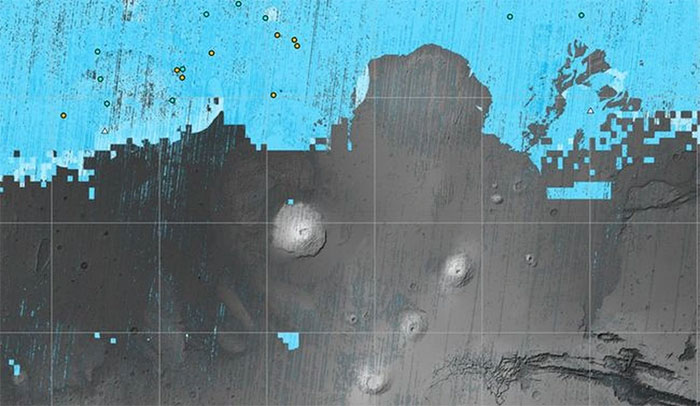NASA releases ice map on Mars
Mapping the ice under the surface of Mars will help mission planners decide on potential landing spots for future astronauts.
Recently, NASA has officially updated the latest map of Mars based on data from the context camera (CTX) and high-resolution image analysis (HIRISE).
This is part of the Mars Subsurface Ice Mapping (SWIM) project led by the Planetary Science Institute, and managed by NASA's Jet Propulsion Laboratory (JPL).

The Subsurface Ice Map of Mars (SWIM) was released by NASA. (Photo: NASA).
In this project, scientists have collated data from many previous Mars missions, to piece together a unified map, showing the potential for ice and water to form below the surface of the Red Planet.
With the latest updated map, mission planners can now pinpoint small impact craters that are believed to have blasted the Martian surface, revealing a 'polygonal terrain' pattern.
These are areas where ice melts and refreezes depending on the weather of certain seasons on Mars.
Knowing where ice can be found on Mars is crucial for crew planning, according to NASA. It is an 'invaluable' resource on space missions, as transporting water from Earth is considered extremely expensive.
The discovered water in ice form will be used to extract drinking water, oxygen and hydrogen. all of these elements can be used to produce rocket fuel, reducing the cost of missions.
Data from the map also allowed planners to avoid landing astronauts in places that were too cold.
If temperatures get too low, the crew will need to use precious energy to keep themselves and their machines warm, making the mission more expensive and more likely to fail.
"If humans ever set foot on Mars, we'll want to land as close to the equator as possible ," said Sydney Do, SWIM project manager.
'An ideal location would then be a landmass that is as low in latitude as possible, but still contains accessible ice. This is where these Martian ice maps come in.'
In addition to mission planning, scientists believe they can also use the SWIM map to better understand why Mars looks the way it does.
The amount of ice found at mid-latitude sites on Mars is not uniform, according to Nathaniel Putzig, co-leader of SWIM at the Planetary Science Institute.
Specifically, some areas seem to have more ice than others, and no one has been able to explain why.
According to him, the latest SWIM map will likely help scientists come up with new hypotheses about why these changes occur, as well as determine the stability of the geological layer on Mars.
- NASA releases photos of 10 'treasures' that may contain evidence of alien life
- NASA plans to 'eavesdrop' on Mars
- NASA has just taken a monstrous photo that looks like a fake about Mars
- NASA releases video of mini-reconnaissance plane flying over Mars
- NASA equipped lasers for Mars to explore Mars
- Why hasn't NASA brought people to Mars?
- NASA's plan to plant potatoes on Mars
- NASA explains the confusing
- NASA's Mars explorer car
- Former NASA employee:
- This is a 6.5-ton car that NASA will use to travel on Mars
- Top 10 photos of Mars
 Announced 3 houses on the Moon and Mars
Announced 3 houses on the Moon and Mars Science proves: Mars also knows 'deflated'
Science proves: Mars also knows 'deflated' Elon Musk announced the price for a Mars trip was 11.6 billion VND, free of charge
Elon Musk announced the price for a Mars trip was 11.6 billion VND, free of charge NASA discovered strange 'gate' on Mars, is the hiding place found?
NASA discovered strange 'gate' on Mars, is the hiding place found?